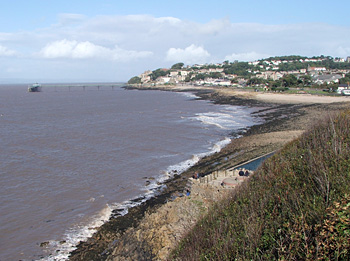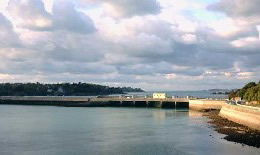Can't see the menu?
Try the text links at the bottom.
Energy Resources:
Tidal power

|
||
The tide moves a huge amount of water twice each day, and harnessing it could provide a great deal of energy - around 20% of Britain's needs. Although the energy supply is reliable and plentiful, converting it into useful electrical power is not easy. There are eight main sites around Britain where tidal power stations could usefully be built, including the Severn, Dee, Solway and Humber estuaries. Only around 20 sites in the world have been identified as possible tidal power stations. A few years ago, "tidal power" meant "tidal barrage", but these days there are other options as well. |
| These work rather like a hydro-electric scheme, except that the dam is much bigger. A huge dam (called a "barrage") is built across a river estuary. When the tide goes in and out, the water flows through tunnels in the dam. The ebb and flow of the tides can be used to turn a turbine, or it can be used to push air through a pipe, which then turns a turbine. Large lock gates, like the ones used on canals, allow ships to pass. If one was built across the Severn Estuary, the tides at Weston-super-Mare would not go out nearly as far - there'd be water to play in for most of the time. But the Severn Estuary carries sewage and other wastes from many places (e.g. Bristol & Gloucester) out to sea. A tidal barrage would mean that this stuff would hang around Weston-super-Mare an awful lot longer! Also, if you're one of the 80,000+ birds that feeds on the exposed mud flats when the tide goes out, then you have a problem, because the tide won't be going out properly any more. |
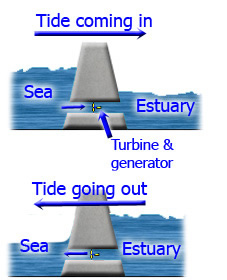 |
|
The largest tidal power station in the world (and the only one in Europe) is in the Rance estuary in northern France, near St. Malo. It was built in 1966.
A major drawback of tidal power stations is that they can only generate when the tide is flowing in or out - in other words, only for 10 hours each day. However, tides are totally predictable, so we can plan to have other power stations generating at those times when the tidal station is out of action. |
Video clip: Tidal barrage, Rance Estuary, France
|
There have been plans for a "Severn Barrage" from Brean Down in Somerset to Lavernock Point in Wales.
Every now and again the idea gets proposed, but nothing has been built yet.
It would cost at least £15 billion to build, but other figures about the project seem to vary depending on where you look.
For example, one source says the Severn Barrage would provide over 8,000 Megawatts of power (that's over 12 nuclear power station's worth), another says it would be equivalent to 3 nuclear power stations.
The variation in the numbers is because there are several different Severn Barrage projects being proposed, so be careful about which numbers you quote if you're a student researching this topic.
There would be a number of benefits, including protecting a large stretch of coastline against damage from high storm tides, and providing a ready-made road bridge.
However, the drastic changes to the currents in the estuary could have huge effects on the ecosystem, and huge numbers of birds that feed on the mud flats in the estuary when the tide goes out would have nowhere to feed.
![]() Find
out more at:
Find
out more at:
| Another option
is to use This has the advantage of being much cheaper to build, and does not have the environmental problems that a tidal barrage would bring. There are also many more suitable sites.
|
![By Ardfern (Own work) [CC-BY-SA-3.0 (http://creativecommons.org/licenses/by-sa/3.0) or GFDL (http://www.gnu.org/copyleft/fdl.html)], via Wikimedia Commons](images/seagen.jpg) |
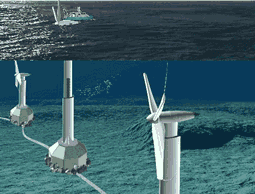  |
The University of Wales Swansea and partners are also researching techniques to extract electrical energy from flowing water. The "Swanturbines" design is different to other devices in a number of ways. The most significant is that it is direct drive, where the blades are connected directly to the electrical generator without a gearbox between. This is more efficient and there is no gearbox to go wrong. Another difference is that it uses a "gravity base", a large concrete block to hold it to the seabed, rather than drilling into the seabed. Finally, the blades are fixed pitch, rather than actively controlled, this is again to design out components that could be unreliable.
|
December 2008: A "Tidal Reef" across the Severn Estuary is being proposed.
At first glance this looks like a tidal barrage, but this design does not block the water movement as much, so it wouldn't affect the tides as severely and the environmental consequences would be much less. It could be built in sections, so power could start being generated sooner. Migratory fish could get through, mud flats could still be exposed at low tide, and it would be able to generate power for more hours in the tidal cycle. Sections of it would open to allow shipping through, and it could be used to control tidal levels further upstream, for example preventing storm surges from flooding low-lying land. (Author's note - I live on low-lying land near the Severn Estuary, so I'm quite keen on this!) Tidal barrages have been built before, whereas this idea is untested - so it'll be interesting to see if it gets approved.
|
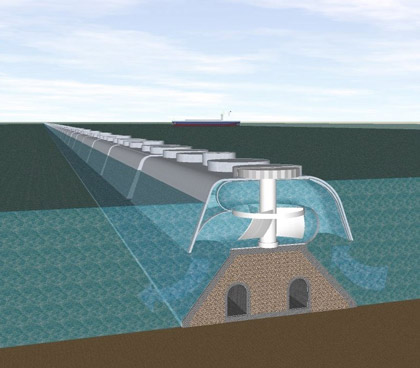 |
| Yet another option:
|
August 2010: BBC News: |
|
- A barrage across an estuary is very expensive to build,
and affects a very wide area - the environment is changed for many
miles upstream and downstream. Many birds rely on the tide uncovering
the mud flats so that they can feed. Fish can't migrate, unless "fish
ladders" are installed.
- Only provides power for around 10 hours each
day, when the tide is actually moving in or out.
- There are few suitable sites for tidal barrages
Tidal energy is renewable. The tides will continue to ebb and flow, and the energy is there for the taking.

Home Fossil Fuels Nuclear Power Solar Power Wind Power Tidal Power Hydroelectric Power Pumped Storage Wave Power Geothermal Power
Biomass Biogas Other Biofuels See also "Stuff to do" on the home page.
This site uses images from www.freefoto.com and www.sxc.hu I am not responsible for the content of external sites linked from this page.
